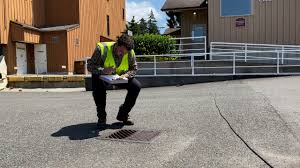1. Know Your Permit (SWPPP Is Key)
- Review your Stormwater Pollution Prevention Plan (SWPPP) regularly—make sure it’s current and tailored to your specific operations.
- Identify your facility’s industrial activities, potential pollutants, and best management practices (BMPs).
- Know your permit requirements: inspection frequency, sampling, reporting, and recordkeeping.

2. Keep Records Spotless
- Maintain organized documentation: inspection logs, maintenance records, training logs, spill response reports, and sampling results.
- Inspectors will often want to see at least three years’ worth of records.
3. Conduct Regular Self-Inspections
- Do quarterly visual assessments and routine facility inspections as required.
- Use a standard checklist—note any deficiencies and corrective actions.
- Take photos of both problem areas and improvements—they help show proactive management.

4. Inspect Stormwater Controls (BMPs)
- Check drainage systems, spill kits, secondary containment, erosion control, etc.
- Clean out catch basins, oil-water separators, and other structural BMPs regularly.
- Verify non-structural BMPs (e.g., housekeeping, employee training) are being followed.
5. Prepare for Sampling (If Required)
- Know when and how to take samples (e.g., first flush during rain events).
- Ensure you have proper equipment, lab access, and chain-of-custody forms.
- Stay familiar with your benchmark values and corrective action triggers.
6. Train Employees
- Provide annual stormwater training to all relevant staff.
- Focus on spill response, BMPs, and recognizing/reporting stormwater issues.
- Have a designated stormwater team or coordinator.
7. Walk the Site Before Inspections
- Do a pre-inspection walk-through before official inspections or audits.
- Look for illicit discharges, poor housekeeping, uncovered materials, or any exposed pollutants.
8. Know How to Interact with Inspectors
- Be courteous and cooperative—they’re there to ensure compliance, not to trip you up.
- Have all documents ready and offer to walk them through the facility.
- If deficiencies are found, document corrective actions and fix issues promptly.
9. Understand Potential Violations

Common issues inspectors flag:
- Uncovered waste/materials exposed to runoff.
- Poorly maintained BMPs.
- Missing/incomplete SWPPP or inspection logs.
- Illicit discharges or spills not addressed.
- Failure to conduct required monitoring or reporting.
10. Stay Ahead
- Consider mock inspections or third-party audits to uncover issues.
- Keep an eye on regulatory updates—stormwater regulations can evolve.
- Treat stormwater compliance as ongoing, not one-and-done.

